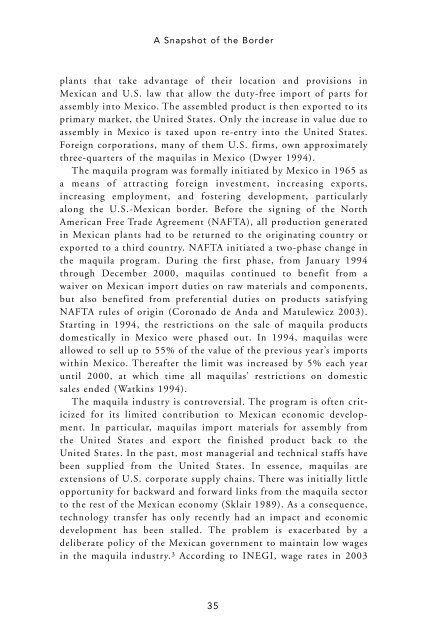Entire Book - Southwest Consortium for Environmental Research ...
Entire Book - Southwest Consortium for Environmental Research ...
Entire Book - Southwest Consortium for Environmental Research ...
You also want an ePaper? Increase the reach of your titles
YUMPU automatically turns print PDFs into web optimized ePapers that Google loves.
A Snapshot of the Border<br />
plants that take advantage of their location and provisions in<br />
Mexican and U.S. law that allow the duty-free import of parts <strong>for</strong><br />
assembly into Mexico. The assembled product is then exported to its<br />
primary market, the United States. Only the increase in value due to<br />
assembly in Mexico is taxed upon re-entry into the United States.<br />
Foreign corporations, many of them U.S. firms, own approximately<br />
three-quarters of the maquilas in Mexico (Dwyer 1994).<br />
The maquila program was <strong>for</strong>mally initiated by Mexico in 1965 as<br />
a means of attracting <strong>for</strong>eign investment, increasing exports,<br />
increasing employment, and fostering development, particularly<br />
along the U.S.-Mexican border. Be<strong>for</strong>e the signing of the North<br />
American Free Trade Agreement (NAFTA), all production generated<br />
in Mexican plants had to be returned to the originating country or<br />
exported to a third country. NAFTA initiated a two-phase change in<br />
the maquila program. During the first phase, from January 1994<br />
through December 2000, maquilas continued to benefit from a<br />
waiver on Mexican import duties on raw materials and components,<br />
but also benefited from preferential duties on products satisfying<br />
NAFTA rules of origin (Coronado de Anda and Matulewicz 2003).<br />
Starting in 1994, the restrictions on the sale of maquila products<br />
domestically in Mexico were phased out. In 1994, maquilas were<br />
allowed to sell up to 55% of the value of the previous year’s imports<br />
within Mexico. Thereafter the limit was increased by 5% each year<br />
until 2000, at which time all maquilas’ restrictions on domestic<br />
sales ended (Watkins 1994).<br />
The maquila industry is controversial. The program is often criticized<br />
<strong>for</strong> its limited contribution to Mexican economic development.<br />
In particular, maquilas import materials <strong>for</strong> assembly from<br />
the United States and export the finished product back to the<br />
United States. In the past, most managerial and technical staffs have<br />
been supplied from the United States. In essence, maquilas are<br />
extensions of U.S. corporate supply chains. There was initially little<br />
opportunity <strong>for</strong> backward and <strong>for</strong>ward links from the maquila sector<br />
to the rest of the Mexican economy (Sklair 1989). As a consequence,<br />
technology transfer has only recently had an impact and economic<br />
development has been stalled. The problem is exacerbated by a<br />
deliberate policy of the Mexican government to maintain low wages<br />
in the maquila industry. 3 According to INEGI, wage rates in 2003<br />
35









